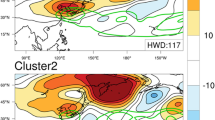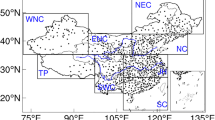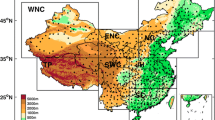Abstract
With the consideration of spatial extension of heatwave events, two kind of regional heatwaves using absolute and relative thresholds, namely RHWs-A and RHWs-R, are investigated during 1959–2013. The temperature data is derived from the daily maximum temperatures (DMTs) of 587 stations in China. Totally 298 RHWs-A and 374 RHWs-R are identified during the past 55 years, and both of them are growing more frequent since the mid-1980s. By utilizing the cluster analysis, several typical spatial distributions of RHWs-A/RHWs-R are obtained. For RHWs-A, there are three clusters covering the southeastern, northwestern China and the lower reaches of Yangtze River, of which the southeastern cluster groups the most heatwaves. For RHWs-R, there are seven clusters distributed throughout the whole regions of China. The clusters in the northwestern and northeastern China are more stable than others for both RHWs-A and RHWs-R, and the northern clusters are of larger intensity than that of the southern ones. All RHWs-A/RHWs-R are accompanied by the anomalous high systems along with the reduced soil moisture. The southern clusters are controlled by Northwestern Pacific subtropical high (WPSH), and the northern ones are influenced by the mid-latitude high systems. The influences of atmospheric circulations and soil moisture on regional heatwaves are further demonstrated by two case analyses of the severe RHW-A in 2003 and the RHW-R in 2013.














Similar content being viewed by others
Change history
19 August 2017
An erratum to this article has been published.
References
Alexander L (2011) Climate science: extreme heat rooted in dry soils. Nat Geosci 4:12–13
Alfaro EJ, Gershunov A, Cayan D (2006) Prediction of summer maximum and minimum temperature over the central and western United States: the roles of soil moisture and sea surface temperature. J Clim 19(8):1407–1421
Anderson GB, Bell ML (2011) Heat waves in the United States: mortality risk during heat waves and effect modification by heat wave characteristics in 43 US communities. Environ Health Perspect 119(2):210
Arblaster JM, Alexander LV (2012) The impact of the El Nino-Southern oscillation on maximum temperature extremes. Geophys Res Lett. doi:10.1029/2012GL053409
Black E, Blackburn M, Harrison G et al (2004) Factors contributing to the summer 2003 European heatwave. Weather 59(8):217–223
Cassou C, Terray L, Phillips AS (2005) Tropical Atlantic influence on European heat waves. J Clim 18(15):2805–2811
Cheng X, Wallace JM (1993) Cluster analysis of the Northern Hemisphere wintertime 500-hpa height field: spatial patterns. J Atmos Sci 50(16):2674–2696
Della-Marta PM, Luterbacher J, von Weissenfluh H et al (2007) Summer heat waves over western Europe 1880–2003, their relationship to large-scale forcings and predictability. Clim Dyn 29(2–3):251–275
Ding T, Qian W (2011) Geographical patterns and temporal variations of regional dry and wet heatwave events in China during 1960–2008. Adv Atmos Sci 28:322–337
Ding T, Qian W, Yan Z (2010) Changes in hot days and heatwaves in China during 1961–2007. Int J Climatol 30(10):1452–1462
Easterling DR, Meehl GA, Parmesan C et al (2000) Climate extremes: observations, modeling, and impacts. Science 289(5487):2068–2074
Ebita A, Kobayashi S, Ota Y et al (2011) The Japanese 55-year reanalysis “JRA-55”: an interim report. Sola 7:149–152
Feudale L, Shukla J (2007) Role of Mediterranean SST in enhancing the European heat wave of summer 2003. Geophys Res Lett 34:L03811
Fischer EM, Schär C (2010) Consistent geographical patterns of changes in high-impact European heatwaves. Nat Geosci 3(6):398–403
Fischer EM, Seneviratne SI, Vidale PL et al (2007) Soil moisture-atmosphere interactions during the 2003 European summer heat wave. J Clim 20(20):5081–5099
Frich P, Alexander LV, Della-Marta P et al (2004) Observed coherent changes in climatic extremes during the second half of the twentieth century. Clim Res 19(3):193–212
García-Herrera R, Díaz J, Trigo RM et al (2010) A review of the European summer heat wave of 2003. Crit Rev Environ Sci Technol 40(4):267–306
Gong DY, Pan YZ, Wang JA (2004) Changes in extreme daily mean temperatures in summer in eastern China during 1955–2000. Theoret Appl Climatol 77(1–2): 25–37
Intergovernmental Panel on Climate Change (2014) Climate change 2014–impacts, adaptation and vulnerability: regional aspects. Cambridge University Press, Cambridge
Kanamitsu M, Ebisuzaki W, Woollen J et al (2002) Ncep-doe amip-ii reanalysis (r-2). Bull Am Meteorol Soc 83(11):1631
Kyselý J (2010) Recent severe heat waves in central Europe: how to view them in a long-term prospect? Int J Climatol 30(1):89–109
Li Q, Liu X, Zhang H, Peterson TC, Easterling DR (2004) Detecting and adjusting temporal in-homogeneity in Chinese mean surface air temperature data. Adv Atmos Sci 21(2):260–268
Lin Z, Lu R, Zhou W (2009) Change in early-summer meridional teleconnection over the western North Pacific and East Asia around the late 1970s. Int J Climatol 30(14):2195–2204
Liu, LL, Sun LH, Liao YM, Zhu YF, Zou XK, Wang YM, Yan JH (2008) Development and application of national prediction system for extreme high temperature. Meteorol Mon 34:102–107
Meehl GA, Tebaldi C (2004) More intense, more frequent, and longer lasting heat waves in the 21st century. Science 305(5686):994–997
Mo K, Ghil M (1988) Cluster analysis of multiple planetary flow regimes. J Geophys Res 93(D9):10927–10952
Peng JB, Cholaw B (2011) The definition and classification of extensive and persistent extreme cold events in China. Atmos Ocean Sci Lett 4(5):281–286
Perkins SE (2015) A review on the scientific understanding of heatwaves—their measurement, driving mechanisms, and changes at the global scale. Atmos Res 164:242–267
Pezza AB, Van Rensch P, Cai W (2012) Severe heat waves in Southern Australia: synoptic climatology and large scale connections. Clim Dyn 38(1–2):209–224
Qi L, Wang Y (2012) Changes in the observed trends in extreme temperatures over China around 1990. J Clim 25(15):5208–5222
Quesada B, Vautard R, Yiou P et al (2012) Asymmetric European summer heat predictability from wet and dry southern winters and springs. Nat Clim Change 2(10):736–741
Ren F, Cui D, Gong Z et al (2012) An objective identification technique for regional extreme events. J Clim 25(20):7015–7027
Robinson PJ (2001) On the definition of a heat wave. J Appl Meteorol 40(4):762–775
Rohini P, Rajeevan M, Srivastava AK (2016) On the variability and increasing trends of heat waves over India. Sci Rep 6:26153
Russo S, Dosio A, Graversen RG et al (2014) Magnitude of extreme heat waves in present climate and their projection in a warming world. J Geophys Res Atmos 119(22):12500–12512
Schär C, Vidale PL, Lüthi D et al (2004) The role of increasing temperature variability in European summer heatwaves. Nature 427(6972):332–336
Shi X, Lu C, Xu X (2011) Variability and trends of high temperature, high humidity, and sultry weather in the warm season in China during the period 1961–2004. J Appl Meteorol Climatol 50(1):127–143
Smith TT, Zaitchik BF, Gohlke JM (2013) Heat waves in the United States: definitions, patterns and trends. Clim Change 118(3–4):811–825
Stéfanon M, Fabio D, Drobinski P (2012) Heatwave classification over Europe and the Mediterranean region. Environ Res Lett 7(1):014023
Sun X, Sun Q, Zhou X et al (2014) Heat wave impact on mortality in Pudong New Area, China in 2013. Sci Total Environ 493:789–794
Tan J, Zheng Y, Song G et al (2007) Heat wave impacts on mortality in Shanghai, 1998 and 2003[J]. Int J Biometeorol 51(3):193–200
Teuling AJ, Seneviratne SI, Stöckli R et al (2010) Contrasting response of European forest and grassland energy exchange to heatwaves. Nat Geosci 3(10):722–727
Vautard R, Yiou P, D’Andrea F, Noblet ND, Viovy N, Cassou C, Polcher J, Ciais P, Kageyama M, Fan Y (2007) Summertime European heat and drought waves induced by wintertime Mediterranean rainfall deficit. Geophys Res Lett 34(7):248–265
Wang Y, Ren F, Zhang X (2014) Spatial and temporal variations of regional high temperature events in China. Int J Climatol 34(10):3054–3065
Wang W, Zhou W, Li X et al (2016) Synoptic-scale characteristics and atmospheric controls of summer heatwaves in China. Clim Dyn 46(9–10):2923–2941
Wei K, Chen W (2011) An abrupt increase in the summer high temperature extreme days across China in the mid-1990s. Adv Atmos Sci 28:1023–1029
Xia J, Tu K, Yan Z et al (2013) The super-heatwave in eastern China during July–August 2013: a perspective of climate change. Int J Climatol 36(3):1291–1298
Xu X, Du Y, Tang J, Wang Y (2011) Variations of temperature and precipitation extremes in recent two decades over China. Int J Biometeorol 101(1):143–154
You Q, Kang S, Aguilar E et al (2011) Changes in daily climate extremes in China and their connection to the large scale atmospheric circulation during 1961–2003. Clim Dyn 36(11–12):2399–2417
Zampieri M, D’Andrea F, Vautard R, Ciais P, Nobletducoudré ND, Yiou P (2009) Hot European summers and the role of soil moisture in the propagation of Mediterranean drought. J Clim 22(18):4747–4758
Zhao P, Zhang X, Li Y, Chen J (2009) Remotely modulated tropical-North Pacific ocean-atmosphere interactions by the South Asian high. Atmos Res 94:45–60
Acknowledgements
This work is supported by the National Natural Science Foundation of China (41375075, 91425304, and 41575099). This work is also supported by the Chinese Jiangsu Collaborative Innovation Center for Climate Change. Observational data was provided by the China Meteorological Administration (CMA).
Author information
Authors and Affiliations
Corresponding author
Additional information
In the original publication of this article, the Fig. 2, Fig. 3, Fig. 8, Fig. 10–14 contains odd black lines; this error has now been corrected.
An erratum to this article is available at https://doi.org/10.1007/s00382-017-3815-6.
Rights and permissions
About this article
Cite this article
Wang, P., Tang, J., Wang, S. et al. Regional heatwaves in china: a cluster analysis. Clim Dyn 50, 1901–1917 (2018). https://doi.org/10.1007/s00382-017-3728-4
Received:
Accepted:
Published:
Issue Date:
DOI: https://doi.org/10.1007/s00382-017-3728-4




